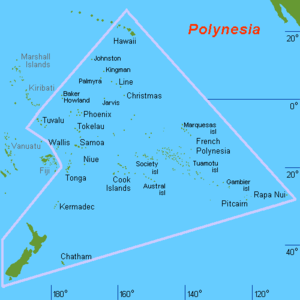



Polynesia[a] (UK: /ˌpɒlɪˈniːziə/ POL-in-EE-zee-ə, US: /-ˈniːʒə/ -EE-zhə) is a subregion of Oceania, made up of more than 1,000 islands scattered over the central and southern Pacific Ocean. The indigenous people who inhabit the islands of Polynesia are called Polynesians. They have many things in common, including linguistic relations, cultural practices, and traditional beliefs.[1] In centuries past, they had a strong shared tradition of sailing and using stars to navigate at night.[2][3]
The term Polynésie was first used in 1756 by the French writer Charles de Brosses, who originally applied it to all the islands of the Pacific. In 1831, Jules Dumont d'Urville proposed a narrower definition during a lecture at the Société de Géographie of Paris. By tradition, the islands located in the southern Pacific have also often been called the South Sea Islands,[4] and their inhabitants have been called South Sea Islanders. The Hawaiian Islands have often been considered to be part of the South Sea Islands because of their relative proximity to the southern Pacific islands, even though they are in fact located in the North Pacific. Another term in use, which avoids this inconsistency, is "the Polynesian Triangle" (from the shape created by the layout of the islands in the Pacific Ocean). This term makes clear that the grouping includes the Hawaiian Islands, which are located at the northern vertex of the referenced "triangle".
Cite error: There are <ref group=lower-alpha> tags or {{efn}} templates on this page, but the references will not show without a {{reflist|group=lower-alpha}} template or {{notelist}} template (see the help page).
- ^ Cite error: The named reference
trhwas invoked but never defined (see the help page). - ^ Holmes, Lowell Don (1 June 1955). "Island Migrations (1): The Polynesian Navigators Followed a Unique Plan". XXV(11) Pacific Islands Monthly. Retrieved 1 October 2021.
- ^ Holmes, Lowell Don (1 August 1955). "Island Migrations (2): Birds and Sea Currents Aided Canoe Navigators". XXVI(1) Pacific Islands Monthly. Retrieved 1 October 2021.
- ^ Russell, Michael (1849). Polynesia: A History of the South Sea Islands, including New Zealand.